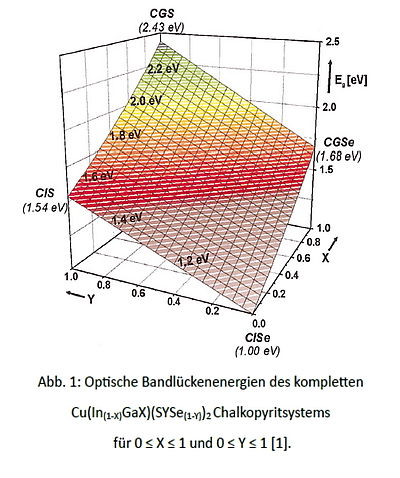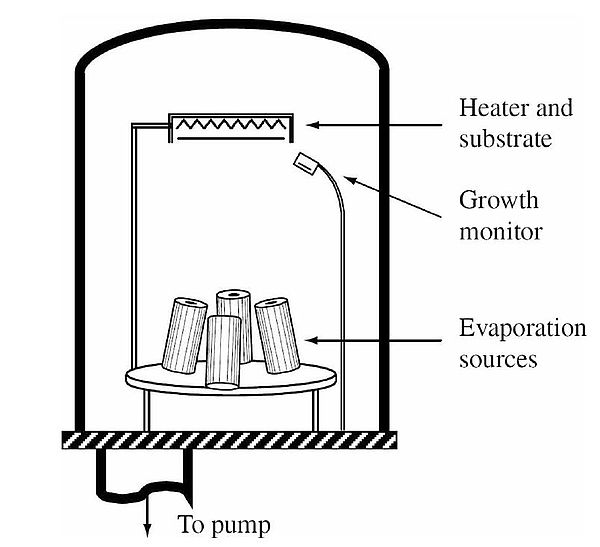Kombination verschiedener fotokatalytischer Nanostrukturen und Materialien für das Design von fotokatalytischen Zellen für eine verbesserte fotoelektrochemische und autonome Wasserspaltung
CuGaSe2 und verwandte Verbindungen als Photokathoden für die photoelektrochemische Wasserspaltung
Halbleitermaterialien aus der Klasse "Kupfer Indium Gallium Schwefel Selen (CIGSSe)" mit unterschiedlichen Zusammensetzungen, auch bekannt als die Chalkopyrite, weisen ein breites Spektrum an Bandlücken zwischen Eg = 1,00 eV bis Eg = 2,43 auf, wie in Abbildung 1 dargestellt [1]. So verändert beispielsweise die Erhöhung des Galliumgehalts in Cu(Inx,Ga1-x)Se2 die Bandlücke von 1,00 eV (CuInSe2 mit x = 0) auf 1,68eV (CuGaSe2 mit x = 1). Um die Bandlücke von CuGaSe2 weiter zu erhöhen, wurden mehrere Schwefelungstechniken zur Bildung von CuGaS2 mit Eg = 2,43 eV untersucht [2].

In photovoltaics, wide-bandgap p-type CuGaSe2 is one of the most promising candidates as the top cell for the preparation of tandem solar cells. However, there are only a few investigations into the application of this material as a photocathode for photoelectrochemical water splitting. Due to its relatively large bandgap of 1.68 eV, the combination of a CuGaSe2 film with a layer of CIGS with a smaller band gap, not only covers nearly the entire solar spectrum, but would also make it possible to generate a sufficiently large photovoltage for running both half reactions involved in the water splitting process.
In this project, we started by depositing various compositions of CuGaxSey films (based on different Cu/Ga atomic ratios) on Mo-coated Soda–lime glass by the so-called single-stage co-evaporation process shown in Figure 2 [3]. These atomic ratios ranged from nearly stoichiometric CuGaSe2 to extremely Cu-poor CuGa3Se5, which can be regarded as the ordered vacancy compound (OVC). With a saturated photocurrent density of ~20 mA/cm2 for CuGaSe2, the PEC performance of all different CuGaxSey compositions were outstanding in comparison to a previous report in the literature [4]. Current research efforts are focused on an in-depth investigation into the PEC properties of these materials and on further improvement of their performance.

[1] M. Bär, W. Bohne, J. Röhrich, E. Strub, S. Lindner, M. C. Lux-Steiner, Ch.-H. Fischer ''Determination of the band gap depth profile of the penternary Cu(In(1?X)GaX)(SYSe(1?Y))2 chalcopyrite from its composition gradient'', Journal of Applied Physics 96, 3857 (2004)
[2] Alexander D. DeAngelis, Kimberly Horsley, and Nicolas Gaillard, "Wide Band Gap CuGa(S,Se)2 Thin Films on Transparent Conductive Fluorinated Tin Oxide Substrates as Photocathode Candidates for Tandem Water Splitting Devices", J. Phys. Chem. C, 2018, 122 (26), 14304–14312
[3] Sreekanth Mandati, Prashant Misra, Bulusu V. Sarada, Tata Narasinga Rao "Copper Chalcopyrites for Solar Energy Applications", Transactions of the Indian Institute of Metals, 2019, Volume 72, 271–288
[4] Christopher P. Muzzillo, W. Ellis Klein, Zhen Li, Alexander Daniel DeAngelis, Kimberly Horsley, Kai Zhu, Nicolas Gaillard'' Low-Cost, Efficient, and Durable H2 Production by Photoelectrochemical Water Splitting with CuGa3Se5 Photocathode'', ACS Appl. Mater. Interfaces 2018, 10, 19573?19579
In der Photovoltaik ist p-Typ CuGaSe2 mit einer relativ großen Bandlücke einer der vielversprechendsten Kandidaten als obere Schicht für die Herstellung von Tandemsolarzellen. Es gibt jedoch nur wenige Untersuchungen zur Anwendung dieses Materials als Photokathode für die photoelektrochemische Wasserspaltung. Die Kombination eines CuGaSe2-Films mit einer Schicht aus CIGS mit kleinerer Bandlücke deckt aufgrund der relativ großen Bandlücke von 1,68 eV nicht nur nahezu das gesamte Sonnenspektrum ab, sondern würde es auch ermöglichen, eine ausreichend große Photospannung zu erzeugen, um beide an der Wasserspaltung beteiligten Halbreaktionen zu betreiben.
In diesem Projekt haben wir bisher verschiedene Zusammensetzungen von CuGaxSey-Schichten (basierend auf unterschiedlichen Cu/Ga-Atomverhältnissen) auf Mo-beschichtetem Natron-Kalk-Glas mittels den in Abbildung 2dargestellten einstufigen Co-Verdampfungsprozess abgeschieden [3]. Diese Atomverhältnisse reichten von nahezu stöchiometrischem CuGaSe2 bis hin zu extrem Cu-armem CuGa3Se5, das als geordnete Vakanz-Verbindung (OVC) angesehen werden kann. Mit einer gesättigten Photostromdichte von ~20 mA/cm2 für CuGaSe2 war die PEC-Leistung aller verschiedenen CuGaxSey-Zusammensetzungen im Vergleich zu einem früheren Bericht in der Literatur hervorragend [4]. Die aktuellen Forschungsarbeiten konzentrieren sich auf eine eingehende Untersuchung der PEC-Eigenschaften dieser Materialien und auf die weitere Verbesserung ihrer Leistungsfähigkeit.

[1] M. Bär, W. Bohne, J. Röhrich, E. Strub, S. Lindner, M. C. Lux-Steiner, Ch.-H. Fischer ''Determination of the band gap depth profile of the penternary Cu(In(1?X)GaX)(SYSe(1?Y))2 chalcopyrite from its composition gradient'', Journal of Applied Physics 96, 3857 (2004)
[2] Alexander D. DeAngelis, Kimberly Horsley, and Nicolas Gaillard, "Wide Band Gap CuGa(S,Se)2 Thin Films on Transparent Conductive Fluorinated Tin Oxide Substrates as Photocathode Candidates for Tandem Water Splitting Devices", J. Phys. Chem. C, 2018, 122 (26), 14304–14312
[3] Sreekanth Mandati, Prashant Misra, Bulusu V. Sarada, Tata Narasinga Rao "Copper Chalcopyrites for Solar Energy Applications", Transactions of the Indian Institute of Metals, 2019, Volume 72, 271–288
[4] Christopher P. Muzzillo, W. Ellis Klein, Zhen Li, Alexander Daniel DeAngelis, Kimberly Horsley, Kai Zhu, Nicolas Gaillard'' Low-Cost, Efficient, and Durable H2 Production by Photoelectrochemical Water Splitting with CuGa3Se5 Photocathode'', ACS Appl. Mater. Interfaces 2018, 10, 19573?19579




